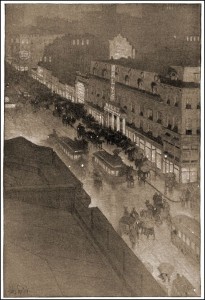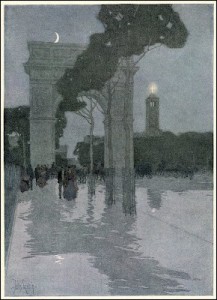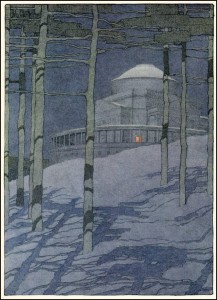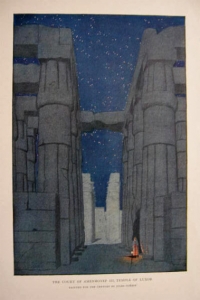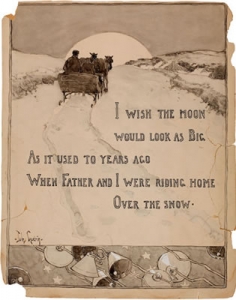Jules Guérin (1866-1946)
A Bit of Broadway: The cavernous maws beneath those blazing boards nightly suck in throngs of amusement seekers
Story illustration for “The Lights and the Stars of Broadway” by John Corbin, in Scribner’s Magazine (February 1905) : p. 133.
Here we are again at the dark of the year: days are short, so nights are long. This is also the season of gray dark days, sometimes heavy with the quiet fall of snow. But there is something comforting about the dark of night that enfolds and cushions us as opposed to the sharp revealing light of day. For me, there were few artists better at revealing the buffering tonality of night than the illustrator Jules Guérin.
Guérin was born in St. Louis and moved to Chicago with his family when he was in his teens. In 1889 he shared a studio with a young Winsor McCay. In the early 1890s Guérin, like many other young artists, worked on the construction and decoration of the many temporary buildings created for the World’s Columbian Exposition, also known as the Chicago World’s Fair which was lit at night by electric lights. A couple of years later Guérin went to Paris to study art. A few years after that he met the artist/illustrator Maxfield Parrish who introduced Guérin to the art directors at Century Magazine. Guérin’s career as an illustrator and an architectural delineator took off from there. By 1900 both aspects of his art were being showcased in popular magazines of the day.
In the 1905 illustration A Bit of Broadway (seen above), notice how Guérin positions the viewer God-like, up above the crowds and rain down in the street; how the electric lit signs and the people on the street appear just a bit fuzzy in the mist of the rain; and how even in the misty rain the lights of Broadway lighten the night sky.* Clearly a detailed observer, Guérin shares the sights and his insights with us so that we feel we are there standing beside him observing.
Jules Guérin (1866-1946)
The Washington Arch in Washington Square. The Hall of Fame (McKim, Mead, & White, Architects),
(Stanford White, Architect) University of the City of New York
Article illustration for “The New New York” by Randall Blackshaw in Century Magazine (August 1902): 494 and 498.
For a 1902 article on the new architectural and civic developments in New York City, Guérin produced some of the most beautiful and expressive of his night scenes. His views of McKim, Mead, & White’s Hall of Fame created for New York University (now the campus of Bronx Community College) is seen from below at the bottom of a hill. The bluish snow-covered ground reflects the moon-shadows of the spare winter-bare trees that stand as sentinels, silently echoing the colonnade surrounding the Gould Memorial Library building.
Night shadows also play an important part in Guérin’s illustration of the Washington Square Arch from the same article. Instead of a snow scene, in this instance Guérin delineates the reflections of buildings, trees, and light in wet pavement. Again his choice of perspective (seen from below as in a worm’s-eye view) makes the arch seem very tall in the street. There are two bright lights in the night sky: the sliver of the moon rising just above the upper cornice of the arch, and in the distance uptown the lit sculpture of Diana created by Augustus Saint-Gaudens to adorn the tower-top of Stanford White’s original Madison Square Garden—neither sculpture or tower are there anymore.**
Jules Guérin (1866-1946)
The Court of Amenhotep III, Temple of Luxor
Story illustration for Robert Hichens, Egypt and Its Monuments (New York: The Century Co., 1908): 93
Jules Guérin was by no means the only illustrator to produce lovely velvety night scenes such as the Temple of Luxor (seen above); Henry McCarter and Everett Shinn, to name a few, also created illustrations of night views in a city. Indeed as cities transitioned from gas light to electric light, the art of darkness became a more commonplace subject. With electrification, night was no longer threatening or frightening, and the juxtaposition between light and dark was now a subject worthy of exploration.
The last illustration by Guérin I leave you with (see below) is a pastoral night scene created for an unknown publication. In it a man alone in a sled, drives his horses and vehicle over the snow toward the horizon. Ahead the rising moon anchors the distant perspective. The thought that illuminates the piece is written over the snowy scene in double edged letters rather like the double-lined tracks the sled marks in the snow. Below as a decorative margin Guérin illustrated ropes of bells ringing in the night—ringing in the new year perhaps.
May you leave tracks behind you of note as you move into the future. Happy New Year.
Jules Guérin (1866-1946)
“I wish the Moon Would Look As Big . . .”, n.d.
Illustration for poem
Watercolor and ink on paper
Sold at Heritage Auctions, October 2011
*The first electric street lights in New York City illuminated a stretch of Broadway from 14th Street to 34th Street. They were turned on for the first time on December 20, 1880.
**The Diana of the Tower is now in the collection of the Philadelphia Museum of Art. It has recently been regilded and glows as it is supposed to.
December 26, 2013
By Joyce K. Schiller, Curator, Rockwell Center for American Visual Studies, Norman Rockwell Museum


